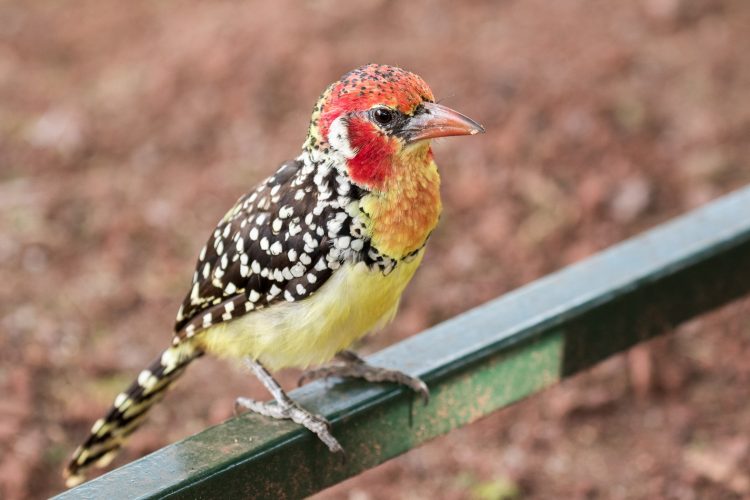The Red and Yellow Barbet, also named “Trachyphonus erythrocephalus” belongs to the African barbet family. This bird can be found in eastern Africa, in woodlands, scrubland, and Savannah, where it regularly forages on the ground near trees or bushes. The Red-and-Yellow barbet is approximately eight or nine inches long.
Red and Yellow Barbet has a long, strong, pointed red bill, and has red, yellow, black, and white upperparts and yellow underparts. The male bird has a black crown and a black chin stripe. The female bird has a red crown with black spots. The legs and feet are blue-grey. The tail is blackish-brown, with 6 to 8 cream colors forming bars. The throat and chin are black, along with a black patch in the center of the throat.
Moreover; the Red and Yellow Barbets typically build nests inside termite mounds (termite nests), using their strong, heavy beaks to break into the mounds. They like to eat fruits and are mostly fond of figs. They also eat seeds, insects, lizards, small birds, and eggs.
These red and yellow barbets are generally comfortable around humans, but they eat food, such as bread, that people waste. Some people keep red-and-yellow barbets as pets. The Masai use the feathers of red-and-yellow barbets as clothing decorations. Therefore, the breeding pair will often belong to a group that consists of the pair and from 1 to 5 “helpers” who support the breeding pair in raising their young. These helpers are habitually younger birds, but there may be 1 or 2 additional adults in the group.
The breeding pair in a group will often sing along to a loud duet, which sounds like the words “red and yellow” being repeated over and over. The helpers sometimes join them in singing with a breeding pair for a short while. Moreover; termite mounds are often used as nesting sites.
However, the barbets dig a tunnel, which is about 16 inches long, inside a termite mound. They build a nesting chamber, lined with grass and feathers, at the end of this tunnel. The female lays between two and six eggs. Both parents help chicks feed on a diet of mostly insects, which are responsible for providing the newly hatched birds with the large amounts of protein that they need. When the chicks grow up and are able to leave the nest, they’ll normally stay close to their parents and become helpers themselves, assisting their parents in raising the next brood. The juvenile birds are a little duller and less red & orange than the female birds. The less-white spot on the back and all blacks are extra brown, along with grey eyes.
Also Read: The Mystery Bird Yellow-Billed Oxpecker

